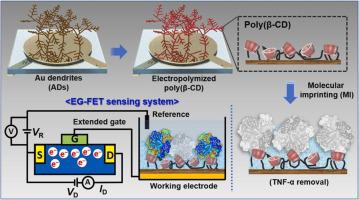当前位置:
X-MOL 学术
›
Sens. Actuators B Chem.
›
论文详情
Our official English website, www.x-mol.net, welcomes your
feedback! (Note: you will need to create a separate account there.)
Determination of tumor necrosis factor-α in serum using extended-gate field-effect transistor-based chemosensors with molecularly imprinted polymer-coated gold dendrites
Sensors and Actuators B: Chemical ( IF 8.0 ) Pub Date : 2023-05-16 , DOI: 10.1016/j.snb.2023.133982 Jin Chul Yang , Seok Jin Lim , Chae Hwan Cho , Deepshikha Hazarika , Jong Pil Park , Jinyoung Park
Sensors and Actuators B: Chemical ( IF 8.0 ) Pub Date : 2023-05-16 , DOI: 10.1016/j.snb.2023.133982 Jin Chul Yang , Seok Jin Lim , Chae Hwan Cho , Deepshikha Hazarika , Jong Pil Park , Jinyoung Park

|
Here, we developed extended-gate field-effect transistor (EG-FET)-based chemosensors with molecularly imprinted polymers (MIPs) on a gold-dendritic (AD) electrode to detect tumor necrosis factor-α (TNF-α) in serum. The poly(β-cyclodextrin) film was electrochemically prepared on the AD electrode using a potentiodynamic technique, followed by TNF-α immobilization by host-guest interaction. The MIP film was formed via electropolymerization of thiophene-3-amidoxime (T3A) monomer in PBS solution with one scan cycle at an applied voltage of 0–1.2 V. After electrochemical optimization, the sensing behavior (based on drain current, ) of the MIP films was investigated to explore the validity of the sensors, resulting in excellent reproducibility, reusability, and stability. Based on the Δ – regression curves obtained in serum containing various analyte concentrations, the imprinting factor (IF) of MIP-based EG-FET sensor was 5.55. The selectivity was evaluated by comparing sensing property using analogous cytokine proteins (interleukin 1β [IL-1β] and interleukin-6 [IL-6]). The MIP-based EG-FET sensors exhibited high sensitivity (LOD: 0.55 pg/mL, LOQ: 1.82 pg/mL) and excellent selectivity (coefficient (α)> 3). Based on the excellent sensing performances, including high sensitivity and selectivity, excellent reproducibility, robustness, reusability, and stability, our (EG-FET)-based chemosensor with TNF-α-recognizing MIP film can be used for the early diagnosis and point–of–care of immune-related diseases.
中文翻译:

使用带有分子印迹聚合物涂层金树突的扩展栅极场效应晶体管化学传感器测定血清中的肿瘤坏死因子-α
在这里,我们开发了基于扩展栅极场效应晶体管(EG-FET)的化学传感器,其在金树突(AD)电极上具有分子印迹聚合物(MIP),用于检测血清中的肿瘤坏死因子-α(TNF-α)。使用动电位技术在 AD 电极上电化学制备聚(β-环糊精)薄膜,然后通过主客体相互作用固定 TNF-α。 MIP 薄膜是通过噻吩-3-偕胺肟 (T3A) 单体在 PBS 溶液中电聚合形成的,在施加电压 0–1.2 V 下进行一个扫描周期。电化学优化后,传感器的传感行为(基于漏极电流)对 MIP 薄膜进行了研究,以探索传感器的有效性,从而获得出色的再现性、可重复使用性和稳定性。根据在含有不同分析物浓度的血清中获得的Δ回归曲线,基于MIP的EG-FET传感器的印迹因子(IF)为5.55。通过比较使用类似细胞因子蛋白(白细胞介素 1β [IL-1β] 和白细胞介素 6 [IL-6])的传感特性来评估选择性。基于 MIP 的 EG-FET 传感器表现出高灵敏度(LOD:0.55 pg/mL,LOQ:1.82 pg/mL)和出色的选择性(系数 (α)> 3)。基于卓越的传感性能,包括高灵敏度和选择性、出色的再现性、鲁棒性、可重复使用性和稳定性,我们的基于 (EG-FET) 的化学传感器具有 TNF-α 识别 MIP 薄膜,可用于早期诊断和点-免疫相关疾病的护理。
更新日期:2023-05-16
中文翻译:

使用带有分子印迹聚合物涂层金树突的扩展栅极场效应晶体管化学传感器测定血清中的肿瘤坏死因子-α
在这里,我们开发了基于扩展栅极场效应晶体管(EG-FET)的化学传感器,其在金树突(AD)电极上具有分子印迹聚合物(MIP),用于检测血清中的肿瘤坏死因子-α(TNF-α)。使用动电位技术在 AD 电极上电化学制备聚(β-环糊精)薄膜,然后通过主客体相互作用固定 TNF-α。 MIP 薄膜是通过噻吩-3-偕胺肟 (T3A) 单体在 PBS 溶液中电聚合形成的,在施加电压 0–1.2 V 下进行一个扫描周期。电化学优化后,传感器的传感行为(基于漏极电流)对 MIP 薄膜进行了研究,以探索传感器的有效性,从而获得出色的再现性、可重复使用性和稳定性。根据在含有不同分析物浓度的血清中获得的Δ回归曲线,基于MIP的EG-FET传感器的印迹因子(IF)为5.55。通过比较使用类似细胞因子蛋白(白细胞介素 1β [IL-1β] 和白细胞介素 6 [IL-6])的传感特性来评估选择性。基于 MIP 的 EG-FET 传感器表现出高灵敏度(LOD:0.55 pg/mL,LOQ:1.82 pg/mL)和出色的选择性(系数 (α)> 3)。基于卓越的传感性能,包括高灵敏度和选择性、出色的再现性、鲁棒性、可重复使用性和稳定性,我们的基于 (EG-FET) 的化学传感器具有 TNF-α 识别 MIP 薄膜,可用于早期诊断和点-免疫相关疾病的护理。


















































 京公网安备 11010802027423号
京公网安备 11010802027423号